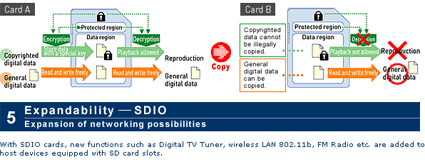When Size Really Matters: Smallest Flash Cards
Small: mmC And SD
Both of these formats are widely available today, everywhere from camera stores to supermarkets. Surface dimensions for both measure out at 24 x 32 mm (0.94 x 1.26 inches). For easy orientation, one corner is slightly cut off, and in sharp contrast to Smart Media cards, these cards are difficult to accidentally misalign or short out. and The interface employs 9 pins: three pins deal with power (two grounds), one is for commands, three are for data, and one is for clocking - because this interface is also a bus - along with a final card detect pin.
The differences between these two types of cards lie in the details. MMC is an older and simpler storage medium for mobile devices, which explains why it's so slim, with a height of only 1.0 mm. SD cards incorporate a microswitch that may be set to engage hardware-based write protection. This leads to a slightly thicker card with a height of 2.1 mm, and explains why an MMC card works in an SD socket or reader, but most SD cards won't fit into MMC slots.
SD cards tout an outmoded copyright protection system developed as a joint effort involving IBM, Intel, Matsushita, and Toshiba known as 4C CPRM (Copyright Protection for Recordable Media; 4C presumably stands for "four companies".) SD cards may only be accessed using authorized devices. With the right kind of software in place, it's possible to make a limited number of copies of data onto such devices, such as from a PC to an SD card.
Get Tom's Hardware's best news and in-depth reviews, straight to your inbox.
Current page: Small: mmC And SD
Prev Page Too Big? Compact Flash Next Page Smaller: mmC Mobile And MiniSD
Patrick Schmid was the editor-in-chief for Tom's Hardware from 2005 to 2006. He wrote numerous articles on a wide range of hardware topics, including storage, CPUs, and system builds.
